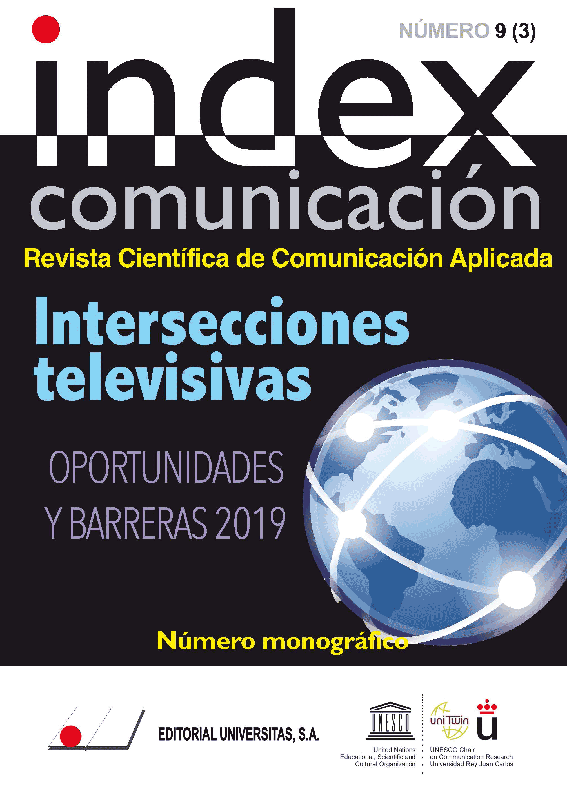Musical Performances in TV Series: Musical-Visual Synchrony as the Main Feature of the Musical Scene
DOI:
https://doi.org/10.33732/ixc/09/03ElnumeKeywords:
Television Fiction, Tv Series, Musical Performance, Music-Visual Synchronisation, Dramedy,Abstract
Musical performances have become a common resource in television fiction. The objectives of this research are to study musical performances and their main characteristics in television fiction; to define the type of music used in these performances; and, finally, to indicate what kind of musical-visual synchronisation is used in the selected samples. In this descriptive study, two procedures have been employed: the bibliographical review and the study of 76 cases of musical performances in different episodes. Television series, mostly in dramedy format, include one or several musical performances in some of their episodes, both as a tribute to the musical genre, as well as a way of offering new content to its audience. In many cases pre-existing music is used, and more specifically, the cover musical format, in order to offer songs performed by the same cast of the series. An important characteristic is the musical-visual synchronisation in these types of scenes. This synchrony is generally categorised as unifying, and it is produced by both the phrasing, facial gestures and body movements of the characters, and by the rhythm of editing in the post-production of the episode.Metrics
References
ALTEN, S. (2008). El sonido en los medios audiovisuales. Andoain: Escuela de Cine y Video.
CALDERÓN, D. (2013). Música y sonido en el ‘lipdub’. En GUSTEMS, J. (Ed.). Música y audición en los géneros audiovisuales. Barcelona: Universidad de Barcelona, pp. 169-177.
CARRASCO, A. (2010). Teleseries: géneros y formatos. Ensayo de definiciones. Miguel Hernández Communication Journal, 1, 174-200.
CASCAJOSA, C. (2016). La cultura de las series. Barcelona: Kaplan.
CASCAJOSA, C. (2009). La nueva edad dorada de la televisión norteamericana. Secuencias,
, 6-31.
CASCAJOSA, C. (2006). No es televisión, es HBO: La búsqueda de la diferencia como indicador de calidad en los dramas del canal HBO. Zer, 11(21), 23-33.
CHION, M. (1993). La audivisión: Introducción a un análisis conjunto de la imagen y el sonido. Barcelona: Paidós comunicación.
FRAILE, T. (2012). Músicas para persuadir: Apropiaciones musicales e hibridaciones genéricas en la publicidad audiovisual. Comunicación, 1 (10), 324-337.
GARCÍA, J. (2013). La inserción del número musical en las series de televisión: El papel de la música en Scrubs. Cuadernos de Etnomusicología, 3, 204-219.
GARCÍA, J. y JOHNSON, S. (2015). Leitmotiv y creación de personajes. La evolución del leitmotiv asociado al personaje de Sira en la serie de ficción El tiempo entre costuras, un primer ejemplo para el análisis musical. Creatividad y Sociedad, (24), 111-137.
GORDILLO, I. (2009). El género ficcional: formatos. En GORDILLO, I. (Ed.). La hipertelevisión: géneros y formatos. Quito-Ecuador: Editorial Ciespal, pp. 99-150.
GUIJARRO, T. y MUELA, C. (2003). La música, la voz, los efectos y el silencio en la publicidad: la creatividad en la producción del sonido. Madrid: CIE Dossat 2000.
LEGUIZAMÓN, J. A. (2001). Exploraciones musicovisuales. Cuadernos, Revista Facultad de Humanidades y Ciencias Sociales de San Salvador de Jujuy, 17, 251-269. Argentina.
LLINARES, F. (2013). La dimensión sonora de los tráileres. En GUSTEMS, J. (Ed.). Música y audición en los géneros audiovisuales. Barcelona: Universidad de Barcelona, pp. 155-167.
MASANET, M. J. y FEDELE, M. (2019). El “chico malote” y la “chica responsable”: modelos aspiracionales y representaciones juveniles en las teen series españolas. Palabra Clave, 22(2).
MOSCHINI, I. (2011). Music and series: the verbalizing role of soundtrack lyrics from TV series to user-generated narrations. Visual Communication, 10(2), 193-208.
OLARTE, M. (2005). El género del musical y la utilización de sus melodías con fines expresivos. En Olarte Martínez, M. (Ed.). La música en los medios audiovisuales: Algunas aportaciones. Salamanca: Plaza Universitaria, pp.101-118.
OLARTE, M. (2010). Nuevos retos para la música en la televisión: Ficción y no ficción. Trípodos, 26, 39-51.
PADILLA, G. y REQUEIJO, P. (2011). Las series de televisión como nuevo vehículo publicitario de la música: Los casos de Disney Channel y Elexandra Patsavas. index.comunicación, 1, 69-87.
PALENCIA-LEFLER, M. (2009). La música en la comunicación publicitaria. Comunicación y Sociedad, 22(2), 89-108.
QUILES, O. y HERRERA, L. (2000). Análisis educativo-musical del medio televisión. Comunicar, 15, 169-174.
RODRÍGUEZ, Á. (2001). La dimensión sonora del lenguaje audiovisual. Barcelona: Paidós Ibérica.
SEDEÑO, A. M. (2008). La relación musicovisual en el videoclip. Propuestas metodológicas y tipología. En de AGUILERA, M.; ADELL, J. E y SEDEÑO, A. (Eds.), Comunicación y música I: Lenguaje y medios. Barcelona: UOC, pp. 121-140.
SELVA, D. (2014). El videoclip: comunicación comercial en la industria musical. Sevilla: Alfar Universidad.
STILWELL, R. (2003). It May Look Like a Living Room…: The Musical Number and the Sitcom. ECHO, 5(1).
ZUAZU, M. y LÓPEZ, R. (2014). Las músicas de Betty, la fea. Latin American Music Review, 35 (1), 1-24.
Published
How to Cite
Issue
Section
License
Copyright (c) 2019 Pedro Galeano Galea

This work is licensed under a Creative Commons Attribution-NonCommercial 4.0 International License.
Authors who submit to this journal agree to the following terms:
Authors retain copyright and ensure the magazine's right to be the first publication of the work as licensed under a Creative Commons Attribution-NoComercial 4.0 International License that allows others to share the work with an acknowledgment of authorship of the work and the initial publication in this magazine, with no commercial purpose.
Authors can establish separate additional agreements for non-exclusive distribution of the version of the work published in the magazine (for example, to an institutional repository or publish it in a book), with an acknowledgment of its initial publication in this journal.
It allows and authors are encouraged to disseminate their work electronically (eg, in institutional repositories or on their own website) prior to and during the submission process, as it can lead to productive exchanges, as well as a citation more early and most of the published work (See The Effect of Open Access).















